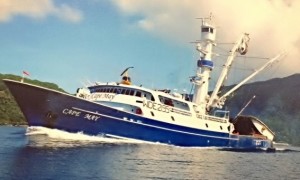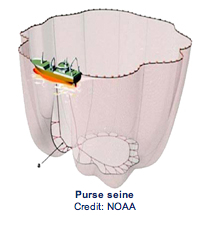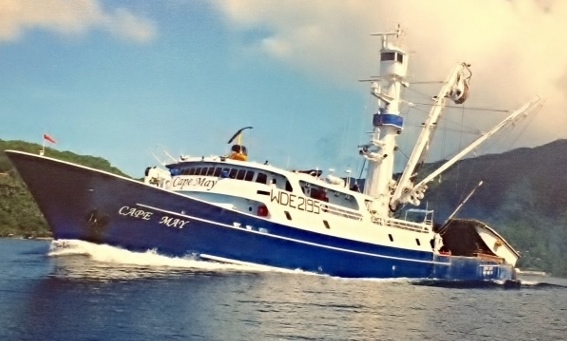In this issue, Environment Hawai`i takes a closer look at the U.S. purse seine fleet fishing in the South Pacific. Although the purse seiners fish thousands of miles from Hawai`i and none regularly pulls into port in Honolulu, they are subject to regulation by the National Marine Fisheries Service’s Pacific Islands Regional Office and the U.S. Coast Guard 14th District, both headquartered in Honolulu.
Given that purse seiners account for almost all the take of juvenile bigeye tuna, it is impossible to understand the disputes over depletion of bigeye stocks without some notion of the role played by the purse seine fishery.

Last May, Tri Marine International, owner of one of two tuna canneries in American Samoa, petitioned the National Marine Fisheries Service. The goal was to get NMFS to adopt a rule that would allow U.S. purse seiners delivering at least half their catch to American Samoa to keep on fishing in the South Pacific past the time when the vessels would be shut out of fishing on the high seas and in waters of the U.S. Exclusive Economic Zones under a fishery management scheme adopted by the Western and Central Pacific Fisheries Commission (WCPFC).
In its petition, Tri Marine cited economic factors that together posed a hardship on purse seiners based in American Samoa and which put “the ability of these tuna vessels to operate profitably … in serious question…. The loss of a reliable supply of tuna from these vessels will jeopardize the ability of the canneries in American Samoa to compete in world markets with lower cost competitors.”
Tri Marine, one of the giants in the tuna industry, has its own purse seine and longline vessels, either owned outright or under contract; processing centers on five continents as well as several Pacific Island states; and a global marketing network. Ten of the 38 purse seiners that currently make up the U.S. fleet fishing in the South Pacific are owned by firms closely affiliated with Tri Marine.
Apart from the Tri Marine vessels that deliver tuna to the Pago Pago canneries, at least six other U.S.-flagged purse seiners regularly deliver there as well, according to Tri Marine.
In an effort to provide a legal foundation for the request, Tri Marine’s attorney, James P. Walsh, argued that under the WCPFC, American Samoa has the right, as a Small Island Developing State (SIDS), to develop its fishery without regard to limits established by the commission’s conservation and management measures. This, Walsh contends, is an argument that NMFS had already endorsed as early as December 2013, when the agency published a federal notice regarding longline limits for bigeye tuna for the years 2014-2017 and specifically excluded all U.S. territories from the limits.
While NMFS denied part of Tri Marine’s petition, leaving its fleet to pursue tuna in regions more distant than those it had traditionally fished for the rest of the year, the agency did agree to consider Tri Marine’s request that it exempt from the fishing limit on the high seas and in U.S. territorial waters “any U.S. flag purse seine vessel which, pursuant to contract or declaration of intent, delivers or will deliver at least 50 percent of its catch to tuna processing facilities based in American Samoa.” On October 23, the agency published an advance notice of proposed rulemaking (ANPR) in the Federal Register, stating that it had determined that the limit “is expected to have substantial adverse economic impacts on U.S. purse seine fishing businesses … and also that adverse impacts in terms of income and employment could occur in business sectors with … links to the producers.”
“However,” the notice continued, “to sufficiently assess whether such impacts, or other circumstances, warrant the regulatory action requested by the petition would require additional information that is not readily available to NMFS, as well as sufficient time to examine such information.”
Furthermore, if the limit for 2015 “is found to impact American Samoa’s fish processing facilities and its economy in the manner alleged in the petition, NMFS would need to determine whether the requested action is appropriate to address the problem and, further, whether it can be implemented consistent with U.S. obligations under the [WCPFC] Convention.”
Or, as Michael Tosatto, head of the Pacific Islands Regional Office of NMFS, explained in a statement to Environment Hawai`i, “The petition for rule-making first asserted that an economic impact was the basis for the petitioned action…. [W]e did not have enough information to determine whether the adverse impact complained of would jeopardize the ability of canneries in American Samoa to compete. The petition then asked for a specific action as relief. We also explained that we did not have sufficient information to determine that the requested relief was appropriate to address the adverse impact complained of (if it exists) and whether such relief could be implemented consistent with US obligations under the [WCPFC] Convention and other applicable laws.”
“But,” he continued, “in the ANPR, we are seeking information on both of these issues – the asserted economic impacts on vessels and shoreside processing in American Samoa and potential relief given our WCPFC obligations overall and specifically with regard to a participating territory.”
ELAPS
The Effort Limit Area for Purse Seine (ELAPS) – the subject of Tri Marine’s complaint – is part of a series of measures adopted by the Western and Central Pacific Fisheries Commission to regulate the catch of tunas in the region under the commission’s jurisdiction. The United States, as a member of the commission, is legally bound to abide by the commission’s conservation measures. ELAPS limits the number of days that U.S.-flagged purse seiners may fish in the open seas and the U.S. exclusive economic zone (EEZ) to 1,828 fishing days in 2015 — a limit that was reached in June.
 U.S. purse seiners may continue to fish in the EEZs of other nations, but to do so, they must pay substantial fees under terms set in the U.S. Tuna Treaty. In addition, some of those nations have severely restricted either the areas in which purse seiners may fish or the number of effort days for purse seiners.
U.S. purse seiners may continue to fish in the EEZs of other nations, but to do so, they must pay substantial fees under terms set in the U.S. Tuna Treaty. In addition, some of those nations have severely restricted either the areas in which purse seiners may fish or the number of effort days for purse seiners.
One of the most significant restrictions is the closure by Kiribati of almost all the waters around the Phoenix islands, due north of American Samoa. Kiribati, which is composed of three discontinuous archipelagos (Gilbert, Line, and Phoenix islands), is small in land mass. Its EEZ, however, is one of the largest in the South Pacific, covering an area of about 1.4 million square miles. Although the Phoenix Islands Protected Area was established in 2008, fishing was prohibited in just 3 percent of the waters. Last January, however, the president of Kiribati, Anote Tong, banned all fishing in the area.
In addition, Kiribati reduced the number of days of fishing allowed to the U.S. purse seine fleet in waters that remain open. In 2014, Tri Marine stated in its petition, Kiribati had allowed the fleet 4,313 fishing days. This year, that was cut to 300 – a reduction of roughly 93 percent.
According to Tracey Chikami, whose family owns the vessel Western Pacific, in recent years, Kiribati had accounted “for almost 45 percent of the U.S. fleet’s fishing effort.”
One Flag, Two Fleets
Comments on Tri Marine’s petition were either strongly favorable – from representatives of the American Samoan government and the Department of Interior’s Office of Insular Affairs, from people who worked at the company’s cannery, from those who provided fuel and services to vessels visiting the port, from StarKist, and from a number of captains of purse seine vessels that supply the two canneries.
Two environmental groups were opposed. Amanda Nickson for the Pew Charitable Trusts noted that overfishing on bigeye tuna, a bycatch of purse-seining, continued to occur, that the number of purse-seine fishing days has increased 18 percent over the last 10 years, and that there was no way to monitor compliance with the exemption that Tri Marine was seeking. Catherine Kilduff, for the Center for Biological Diversity, pointed out that “creating exemptions from catch limits undermines conservation of bigeye tuna.” In addition, she argued, NMFS had no legal basis to allow such an exemption, which would “allow essentially unlimited purse seine fishing on the high seas for any U.S.-flagged vessel” promising to deliver half its catch to American Samoa.
The most heated opposition, however, came from J. Douglas Hines of South Pacific Tuna Corporation and Bumble Bee’s Chris Lischewski.
Lischewski claimed the relief sought by Tri Marine was “designed to provide an economic benefit to our vertically integrated competitors … by lowering their production cost. Because U.S. purse seine vessels delivering to those processing facilities, including the vessels owned by our competitors, would not be required to purchase fishing days, the cost to their vessels harvesting tuna would be significantly lower…. Tuna processors in American Samoa are already exempt from local taxes, receive federal tax credits (Sec. 30A) and pay a very low minimum wage (currently $4.76). Providing them with an opportunity to avoid purchasing fishing days or paying less for raw material would only harm Bumble Bee and other tuna processors … that have made major investment in U.S. facilities.” (Tri Marine’s chief operating officer, Joe Hamby, has stated that Tri Marine is not eligible for tax relief under Section 30A of the tax code, which grants credit for certain investments made in American Samoa.)
Hines weighed in no fewer than four times over the course of the comment period for the petition, stating that he was representing 22 of the 37 U.S.-flagged purse seiners. By the time he made his last comment, on August 14 – three days before the comment period closed – Hines had backed off somewhat from the “strong opposition” he had initially expressed. “After consultation with industry and interested parties,” he wrote, “we have received clarification on a number of our pending issues … raised in our initial comment letter.”
He was still bothered by the fact that the petition would grant “a commercial advantage to one sector of the industry which would be a clear violation of … the Magnuson Stevens Act,” which governs marine fishing by U.S.-flagged vessels.
In responding to Hines, Curto recapped some of the history of the purse-seine fleet in the United States. “The vessels which Mr. Hines claims to represent have nothing to do with the American Samoa tuna purse seine fishery,” he wrote. “They belong to another fishery, one that is based on transshipment and supplying their catch to markets other than American Samoa markets that compete directly with American Samoa’s tuna fishery and industry.”
In 2001, he wrote, he and his partners purchased eight U.S.-flagged purse seiners. By 2006, as a result of low prices and low-cost competitors, the fleet was at its low point, with no more than 13 U.S. vessels active in the Western and Central Pacific.
“In 2007 … we became aware of an initiative by U.S. and Taiwanese interests to build a large number of tuna purse seiners in Taiwan for operation in the Western and Central Pacific under the U.S. [Tuna] Treaty…. At first Tri Marine was publicly against this planned expansion of the tuna purse seine fleet as we didn’t see the need for more fishing capacity … and we didn’t think that the U.S. Treaty needed more boats for its survival.
“… My view then and still today is that the underlying economic stimulus and financing for this project came from the two Taiwanese shipyards that built these new boats. Those shipyards needed U.S. citizens to own at least 50 percent of these new boats… Bumble Bee and Chicken of the Sea, as companies, did not qualify as they were and still are majority foreign owned. Instead, certain executives and employees of Bumble Bee and other U.S. citizens joined together to fulfill the U.S. flag citizenship requirements for these boats…. Their model is based on catching as much fish as possible without being tied to a particular processing plant…. Instead of producing canned tuna from whole round fish, they have highly automated factories that use frozen, cooked, and cleaned tuna loins as the raw material.”
Curto concluded by asking that NMFS “understand that there are two different U.S. fisheries operating in the Western and Central Pacific under the same U.S. treaty.”
* * *
Violations
A closer look at the U.S.-flagged purse seiners currently holding a license to fish in the Western Pacific does show deep divisions.
Slightly more than half the fleet (20 vessels) were built after 2000. This category includes all of the South Pacific Tuna Corporation purse seiners and the four vessels associated with the Taiwanese company Trans Global Products. Just one of Tri Marine’s fleet is in this category: the Cape Ann, built in 2015. Seventeen were built prior to 1990.
The vessels also fall into two categories when it comes to compliance with U.S. and international laws.
A review by Environment Hawai`i of enforcement actions against the tuna fleet found those belonging to the South Pacific Tuna Corporation were cited many more times than those associated with any other operator:
- In 2012, five SPTC vessels were found to be in violation of U.S. Coast Guard manning requirements by employing unlicensed foreign personnel to fill the roles of chief mate and chief engineer.
- Just this past August, a federal appeals court upheld an administrative law judge’s finding that five SPTC vessels had engaged in a variety of prohibited actions, including five counts of setting their nets on whales (in violation of the Marine Mammal Protection Act), 10 counts of setting on or near a fish-aggregating device (FAD) during the 2009 FAD closure period, and two counts of deploying FADs during the closure. The court upheld a combined penalty assessment of $953,053.94 against the company.
- The Ocean Conquest has been charged with an MMPA violation, with a proposed fine of $11,000. That penalty is under review by the administrator of the National Oceanic and Atmospheric Administration.
- The Pacific Ranger has been charged with five counts of MMPA violations, with a proposed fine of $149,250. After an administrative hearing, the fine was reduced $127,000. That decision is on appeal to the U.S. District Court.
- The Ocean Challenger has agreed to pay a compromise penalty of $123,750 for two counts of setting during a FAD closure.
- The Ocean Warrior agreed to a compromise fine of $202,000 for two counts on setting on FADS during the FAD closure.
- In 2014, the SPTC vessel Sea Bounty paid $125,000 to the Marshall Islands Marine Resources Authority to settle allegations that it was catching and finning silky sharks inside Majuro lagoon. The same vessel was also reported to have been setting on a whale shark inside Marshall Islands waters. (In 2013, acknowledging that silky sharks had become seriously depleted, the WCPFC adopted a conservation measure that prohibited the retention, transshipment, storing, or landing of any silky shark caught in its waters. The prohibition took effect on July 1, 2014.)
Vessels associated with Trans Global Products make up the fleet with the second highest number of violations:
- The American Eagle was fined $59,400 for 6 counts of violating the MMPA by setting its net on whales.
- The American Triumph was fined $14,100 for violating the MMPA by harassing an observer and $72,669.75 for setting on a FAD during the FAD closure period. This past August, the U.S. District Court in the District of Columbia upheld an administrative law judge’s finding that affirmed a fine of $562,068.27 for additional FAD violations dating back to 2009.
- The American Victory paid $111,351.10 to settle charges that it violated the MMPA by setting on a whale and set on or serviced a FAD during the FAD closure period.
AACH Holdings has paid $153,000 in fines for two MMPA violations and two FAD violations by the Daniela. In September, an administrative law judge assessed a fine of $21,000 for three additional MMPA violations. AACH’s other purse seiner, the Isabella, was fined $110,000 for fishing in a closed area and a total of $58,000 for eight separate counts of MMPA violations.
Just one infraction was associated with Tri Marine: earlier this year, the company agreed to pay $1.05 million in fines related to an oil spill that occurred in Pago Pago harbor in October 2014. In that incident, the Capt. Vincent Gann, while maneuvering to shift moorings, hit two other vessels. As a result, the Capt. Vincent Gann suffered a large gash in its hull and at least 35 barrels – about 500 gallons – of oil spilled from the bulb in the vessel’s bow, where it had been illegally stored forward of the collision bulkhead.
— Patricia Tummons



Leave a Reply